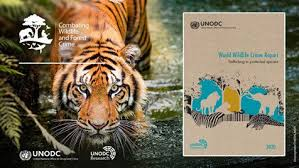Description

Disclaimer: Copyright infringement is not intended.
Context:
- The rhino and the cedar were the animal and plant species most affected by global illegal wildlife trade during 2015-2021, the 2024 World Wildlife Crime Report released by the United Nations Office on Drugs and Crime noted.
Key Findings:
- Most Affected Species: The report identifies the rhino and the cedar (along with other Sapindales species) as the most affected animal and plant species, respectively. Rhino horn constituted 29% of the observed illegal wildlife trade, while cedars and other Sapindales comprised 47% of the plant trade.
- Top Markets: Among animal species, the markets for pangolin scales (28%) and elephant ivory (15%) follow rhino horn in terms of volume. For plants, rosewoods (35%) and agarwood (13%) are significant markets after cedars.
- Diversity of Seized Products: Seizures of biodiversity products during the period were diverse. Corals comprised 16% of all seizures, followed by crocodilians (9%), and elephants (6%).
- Types of Commodities Seized: Coral pieces constituted the largest portion of seizures (16%), followed by live specimens (15%), and animal product medicines (10%).
Key Takeaways from the report:
- Persistent Challenge: Despite efforts, wildlife trafficking persists globally. Traffickers remain adaptable and utilize various methods to evade detection.
- Need for Stronger Cooperation: The report emphasizes the need for policy harmonization, and international cooperation across the trade chain to address wildlife trafficking effectively.
- Addressing Corruption and Technology: Corruption undermines regulation and enforcement, while technology facilitates traffickers' global reach. The report advocates for modernizing criminal justice responses to counter these challenges.
- Strategic Interventions: With numerous species affected, interventions must be prioritized and strategically made.
- Organized Crime Connection: Wildlife crime is often intertwined with organized crime. Therefore, a broader strategy to address organized crime as a whole is necessary to combat wildlife trafficking effectively.
Conclusion:
- The 2024 World Wildlife Crime Report calls for the urgent need for concerted international efforts to combat illegal wildlife trade.
- By addressing corruption, enhancing cooperation, and adopting strategic interventions, stakeholders can work towards mitigating the devastating impacts of wildlife trafficking on biodiversity and ecosystems globally.
|
World Wildlife Crime Report 2024
●The World Wildlife Crime Report 2024 is the third report in a series following the 2020 and 2016 publications.
●The data in the report is largely derived from the available national annual illegal trade reports, which CITES Parties are required to submit each year.
●The report provides an updated focus on trends in the illegal trade in wildlife species listed in the Convention on International Trade in Endangered Species of Wild Fauna and Flora (CITES).
●It presents a systematic analysis of wildlife crime harms and impacts, probes the factors driving wildlife trafficking trends, and takes stock of current knowledge about the effectiveness of the different types of interventions being pursued to resolve wildlife crime.
|
Source:
https://theprint.in/india/leopard-cat-sighted-in-maharashtras-pench-tiger-reserve-for-first-time-official/2081611/
|
PRACTICE QUESTION
Q. Critically analyze the findings and recommendations of the 2024 World Wildlife Crime Report regarding illegal wildlife trade. Discuss the key challenges hindering effective enforcement against wildlife trafficking and assess the significance of international cooperation and policy harmonization in combating this global phenomenon.(250 words)
|












